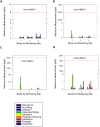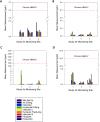Health-based evaluation of ambient air measurements of PM2.5 and volatile organic compounds near a Marcellus Shale unconventional natural gas well pad site and a school campus
- PMID: 33619364
- PMCID: PMC8263344
- DOI: 10.1038/s41370-021-00298-5
Health-based evaluation of ambient air measurements of PM2.5 and volatile organic compounds near a Marcellus Shale unconventional natural gas well pad site and a school campus
Abstract
Background: Limited air monitoring studies with long-term measurements during all phases of development and production of natural gas and natural gas liquids have been conducted in close proximity to unconventional natural gas well pads.
Objective: Conducted in an area of Washington County, Pennsylvania, with extensive Marcellus Shale development, this study investigated whether operations at an unconventional natural gas well pad may contribute to ambient air concentrations of potential health concern at a nearby school campus.
Methods: Almost 2 years of air monitoring for fine particulate matter (PM2.5) and volatile organic compounds (VOCs) was performed at three locations between 1000 and 2800 feet from the study well pad from December 2016 to October 2018. PM2.5 was measured continuously at one of the three sites using a beta attenuation monitor, while 24-h stainless steel canister samples were collected every 6 days at all sites for analysis of 58 VOCs.
Results: Mean PM2.5 concentrations measured during the different well activity periods ranged from 5.4 to 9.5 μg/m3, with similar levels and temporal changes as PM2.5 concentrations measured at a regional background location. The majority of VOCs were either detected infrequently or not at all, with measurements for a limited number of VOCs indicating the well pad to be a source of small and transient contributions.
Significance: All measurement data of PM2.5 and 58 VOCs, which reflect the cumulative contributions of emissions from the study well pad and other local/regional air pollutant sources (e.g., other well pads), were below health-based air comparison values, and thus do not provide evidence of either 24-hour or long-term air quality impacts of potential health concern at the school.
Keywords: Air monitoring; Marcellus Shale; Natural gas; PM2.5; Public health; VOCs.
Conflict of interest statement
During involvement in the study, authors were employed by Gradient or AECOM. The work reported in this paper was conducted during the normal course of employment. Range Resources, which provided financial support for this study and paper, developed and currently operates the study well pad, as well as other well pads in the local area. The authors had complete freedom in the design, implementation, and reporting of the research presented in this paper; the paper was reviewed by employees of Range Resources while in preparation. The authors retain sole responsibility for the writing and content of this paper, which represent the professional opinions of the authors and not necessarily those of Range Resources. One of the authors of this manuscript (C. Long) has testified in Pennsylvania on behalf of natural gas development companies at local zoning hearing board meetings and at a judicial hearing on the science of the air quality impacts of Marcellus Shale development activities.
Figures




Similar articles
-
Synthesis and health-based evaluation of ambient air monitoring data for the Marcellus Shale region.J Air Waste Manag Assoc. 2019 May;69(5):527-547. doi: 10.1080/10962247.2019.1572551. Epub 2019 Mar 11. J Air Waste Manag Assoc. 2019. PMID: 30698507 Review.
-
Human exposure to unconventional natural gas development: A public health demonstration of periodic high exposure to chemical mixtures in ambient air.J Environ Sci Health A Tox Hazard Subst Environ Eng. 2015;50(5):460-72. doi: 10.1080/10934529.2015.992663. J Environ Sci Health A Tox Hazard Subst Environ Eng. 2015. PMID: 25734822
-
Impact of emissions from natural gas production facilities on ambient air quality in the Barnett Shale area: a pilot study.J Air Waste Manag Assoc. 2014 Dec;64(12):1369-83. doi: 10.1080/10962247.2014.954735. J Air Waste Manag Assoc. 2014. PMID: 25562933
-
Impact of Marcellus Shale natural gas development in southwest Pennsylvania on volatile organic compound emissions and regional air quality.Environ Sci Technol. 2015 Mar 3;49(5):3175-84. doi: 10.1021/es504315f. Epub 2015 Feb 12. Environ Sci Technol. 2015. PMID: 25594231
-
Indoor Exposure to Selected Air Pollutants in the Home Environment: A Systematic Review.Int J Environ Res Public Health. 2020 Dec 2;17(23):8972. doi: 10.3390/ijerph17238972. Int J Environ Res Public Health. 2020. PMID: 33276576 Free PMC article.
Cited by
-
Altered oxidative stress and antioxidant biomarkers concentrations in pregnant individuals exposed to oil and gas sites in Northeastern British Columbia.Toxicol Sci. 2024 Sep 1;201(1):73-84. doi: 10.1093/toxsci/kfae080. Toxicol Sci. 2024. PMID: 38897649 Free PMC article.
References
-
- Allegheny County, Pennsylvania, Health Dept (ACHD). Imperial pointe ambient air sampling results/method EPA TO15+ tentatively identified compounds. 2016 Sep 21. 13 p. [217-3287]
Publication types
MeSH terms
Substances
LinkOut - more resources
Full Text Sources
Other Literature Sources

